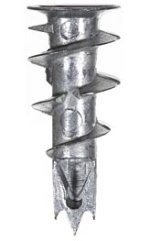Hello
I've just moved into a new place, built in 1924.
I need to mount some IKEA floating shelves onto a plasterboard wall. Due to the required positioning of the shelves, I can't use the studs and so I have had to use special fixings for the plasterboard.
I picked this type of fixing:

All was going well - I'd marked out everything. I'd drilled 3mm pilot holes. Then the plugs just self tap in with a screwdriver. Some kept on turning once flush with the wall, which was very worrying. Then, when screwing the floating shelf bracket to the fixing, the wall site just crumbled: the fixings kept on tapping into the wall.
Now I have no confidence that the fixings are secure and I don't want to mount the shelf. I also have a wall that looks awful. Any idea what I've done wrong?
Thanks!
I've just moved into a new place, built in 1924.
I need to mount some IKEA floating shelves onto a plasterboard wall. Due to the required positioning of the shelves, I can't use the studs and so I have had to use special fixings for the plasterboard.
I picked this type of fixing:

All was going well - I'd marked out everything. I'd drilled 3mm pilot holes. Then the plugs just self tap in with a screwdriver. Some kept on turning once flush with the wall, which was very worrying. Then, when screwing the floating shelf bracket to the fixing, the wall site just crumbled: the fixings kept on tapping into the wall.
Now I have no confidence that the fixings are secure and I don't want to mount the shelf. I also have a wall that looks awful. Any idea what I've done wrong?
Thanks!

